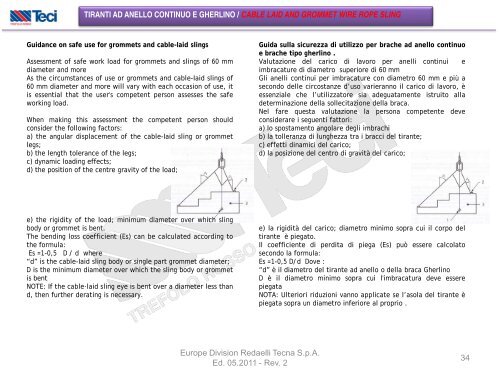You also want an ePaper? Increase the reach of your titles
YUMPU automatically turns print PDFs into web optimized ePapers that Google loves.
TIRANTI AD ANELLO CONTINUO E GHERLINO / CABLE LAID AND GROMMET WIRE ROPE SLING<br />
Guidance on safe use for grommets and cable-Iaid slings<br />
Assessment of safe work load for grommets and slings of 60 mm<br />
diameter and more<br />
As the circumstances of use or grommets and cable-Iaid slings of<br />
60 mm diameter and more w<strong>il</strong>l vary with each occasion of use, it<br />
is essential that the user's competent person assesses the safe<br />
working load.<br />
When making this assessment the competent person should<br />
consider the following factors:<br />
a) the angular displacement of the cable-Iaid sling or grommet<br />
legs;<br />
b) the length tolerance of the legs;<br />
c) dynamic loading effects;<br />
d) the position of the centre gravity of the load;<br />
e) the rigidity of the load; minimum diameter over which sling<br />
body or grommet is bent.<br />
The bending loss coefficient (Es) can be calculated according to<br />
the formula:<br />
Es =1-0,5 D / d where<br />
“d” is the cable-Iaid sling body or single part grommet diameter;<br />
D is the minimum diameter over which the sling body or grommet<br />
is bent<br />
NOTE: If the cable·laid sling eye is bent over a diameter less than<br />
d, then further derating is necessary.<br />
Europe Division Redaelli Tecna S.p.A.<br />
Ed. 05.2011 - Rev. 2<br />
Guida sulla sicurezza di ut<strong>il</strong>izzo per brache ad anello continuo<br />
e brache tipo gherlino .<br />
Valutazione del carico di lavoro per anelli continui e<br />
imbracature di diametro superiore di 60 mm<br />
Gli anelli continui per imbracature con diametro 60 mm e più a<br />
secondo delle circostanze d’uso varieranno <strong>il</strong> carico di lavoro, è<br />
essenziale che l’ut<strong>il</strong>izzatore sia adeguatamente istruito alla<br />
determinazione della sollecitazione della braca.<br />
Nel fare questa valutazione la persona competente deve<br />
considerare i seguenti fattori:<br />
a) lo spostamento angolare degli imbrachi<br />
b) la tolleranza di lunghezza tra i bracci del tirante;<br />
c) effetti dinamici del carico;<br />
d) la posizione del centro di gravità del carico;<br />
e) la rigidità del carico; diametro minimo sopra cui <strong>il</strong> corpo del<br />
tirante è piegato.<br />
Il coefficiente di perdita di piega (Es) può essere calcolato<br />
secondo la formula:<br />
Es =1-0,5 D/d Dove :<br />
“d” è <strong>il</strong> diametro del tirante ad anello o della braca Gherlino<br />
D è <strong>il</strong> diametro minimo sopra cui l'imbracatura deve essere<br />
piegata<br />
NOTA: Ulteriori riduzioni vanno applicate se l’asola del tirante è<br />
piegata sopra un diametro inferiore al proprio .<br />
34






